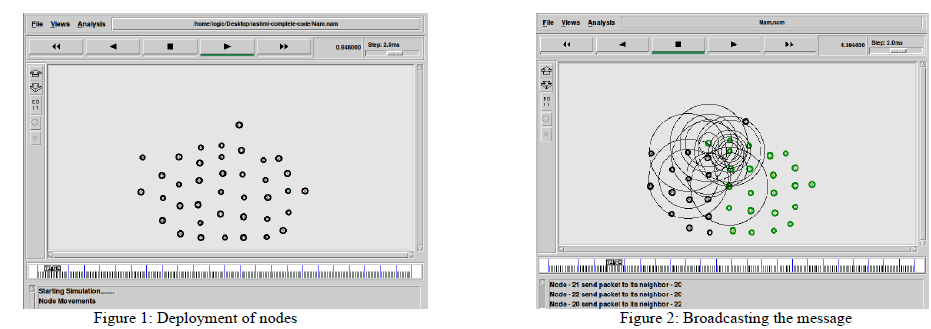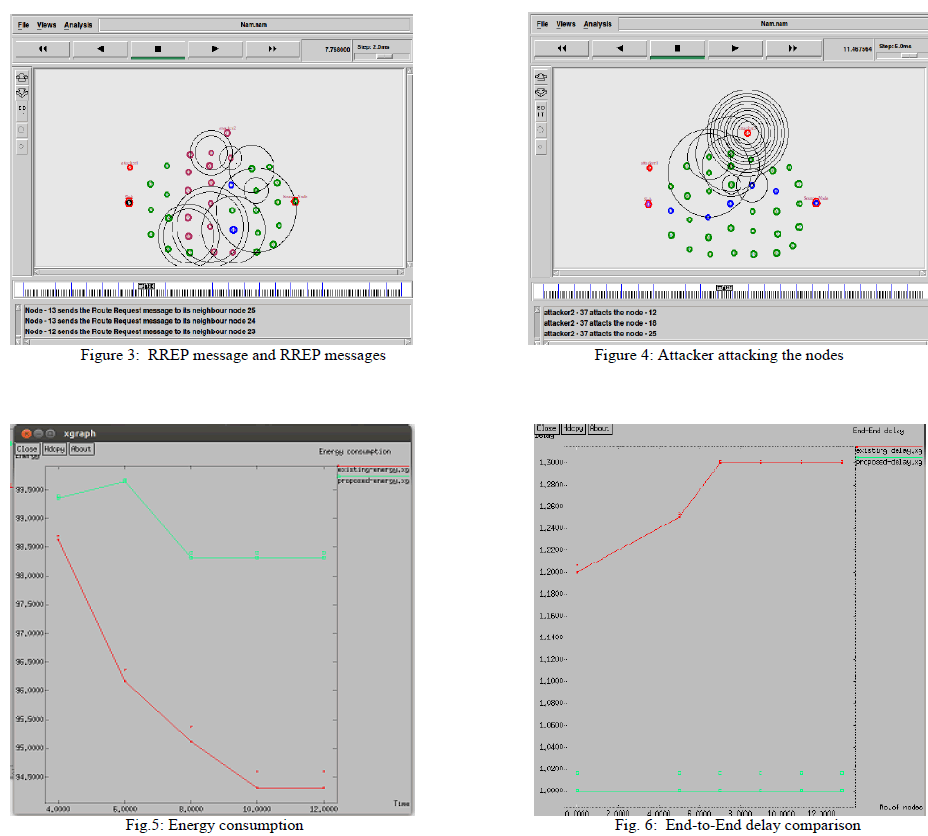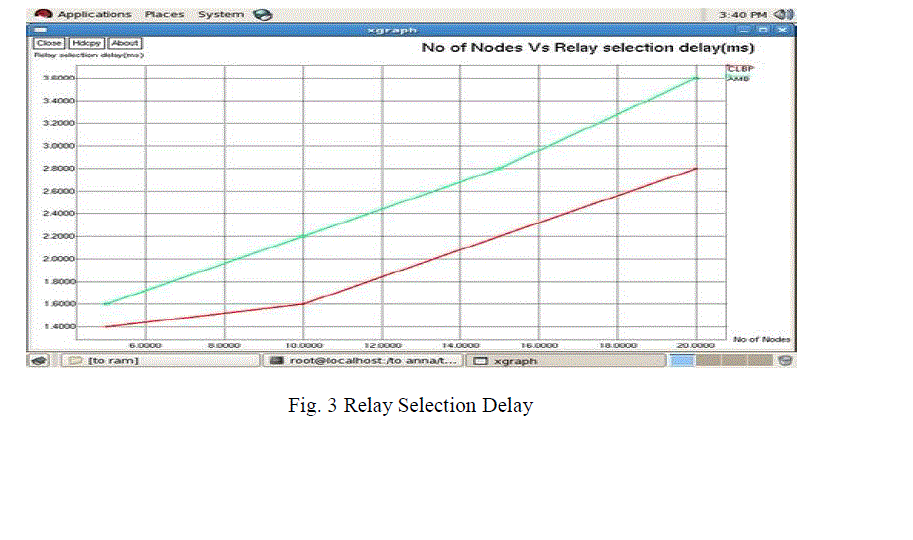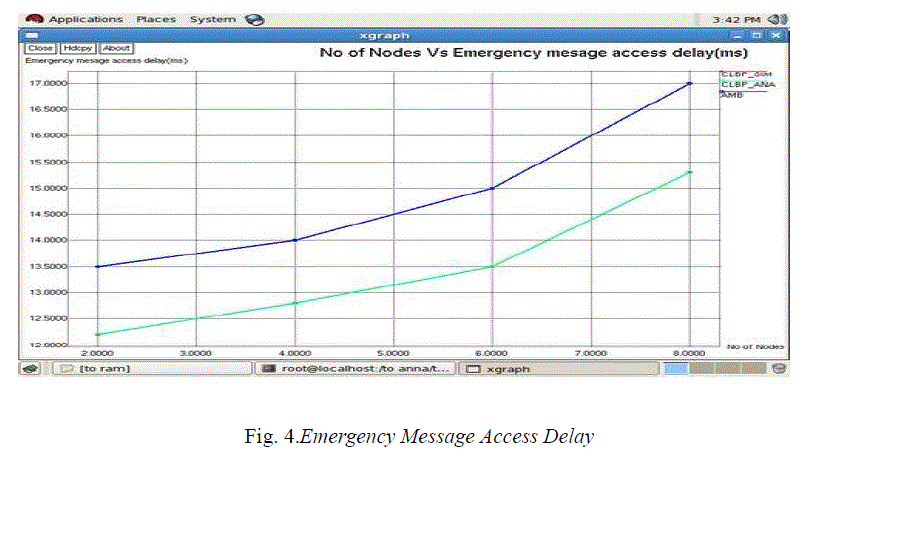Keywords
|
| Broadcast protocol, cross-layer design, inter-vehicle communication (IVC). |
INTRODUCTION
|
| Nowadays, there is a huge increase of handheld devices. Laptops, mobile phones and PDAs take an important place in the everyday life. Hence, the challenge is now to make all their devices communicate together in order to build a network obviously this kind of networks has to be wireless. |
| Indeed, the wireless topology allows flexibility and mobility. In this context, the idea of ad-hoc networks was developed. A Vehicular Ad-Hoc Network, or VANET, is used to provide communications among nearby vehicles. The main goal of VANET is providing safety and comfort for passengers. |
| A special electronic device will be placed inside each vehicle which will provide Ad-Hoc Network connectivity for the passengers. This network tends to operate without any infra-structure or legacy client and server communication. Each vehicle equipped with VANET device will be a node in Ad-Hoc network and can receive and relay others messages through the wireless network. Collision warning, road sign alarms and in-place traffic view will give the driver essential tools to decide the best path along the way. The remaining chapters are organized as follows, a brief overview of the system in chapter 2. The methodology of cross layer broadcast protocol is detailed in chapter 3. The analytical and simulation result of cross layer broadcast protocol is shown and they are compared with ad-hoc multihop broadcast protocol in chapter 4, followed by conclusion and future work in chapter 5. |
OVERVIEW OF THE SYSTEM
|
| Broadcast transmission is a frequently used method to transmit information in VANETs. Nevertheless, effectivelybroadcasting emergency messages to other vehicles in IVCis extremely challenging, particularly due to high mobilityand a hostile wireless environment. First, no acknowledgment (ACK) mechanism is applied for broadcast messages inthe medium-access-control (MAC) layer, message loss due topacket collisions or poor channel conditions cannot be easilydetected. Since life-critical emergency messages have to be deliveredto other vehicles as fast and reliable as possible thetraditional broadcasting scheme without an ACK mechanism isnot suitable for emergency message delivery in IVC. |
| Second,due to the limited transmission range, message relaying fromintermediate nodes is required to reach remote vehicles then only the transmission would be effective. However, without an effective broadcast control mechanism, multiplecopies of the broadcast messages may be delivered amongnodes, which could result in a broadcast storm problem and it, degrade the network resource utilization. Some research workspropose to reduce message redundancy and preventbroadcaststorm by selecting subset ofneighboring nodes to forward thebroadcast message. However, it is a nontrivial task to determinea proper subset of nodes that can simultaneously guarantee themessage reliability and achieve efficient resource utilization. |
| To address the aforementioned issues, several broadcastingprotocols have been proposed in the literature. Some protocolsmake use of network-layer broadcast-control algorithmsto reduce the message redundancy, but they cannotguarantee the MAC layer reliability. Other protocols aim at improvingthe transmission reliability by repeatedly broadcasting messages or selecting the farthest node to relay messages. However, repeated broadcast cannot completelyguarantee the transmission reliability but degrades the resourceutilization. The farthest node may suffer from a high packeterror rate (PER) and is not an ideal relay candidate, particularlyin high-speed vehicle networks.In this paper, a Cross Layer Broadcast Protocol (CLBP)is used for emergency message dissemination in IVC, it aims to improve the transmission reliability, minimize the message redundancy, and reduce the link delay. First a novel relaying metric is designed, which is composed of geographical locations, physical-layer channel conditions, and moving velocities of vehicles. Based on the metric, a revised request-to send/clear-to-send (RTS/CTS) scheme to distributedly select an appropriate relaying node. Specifically, after receiving a broadcast RTS (BRTS) frame, each relay candidate starts its backoff timer to reply a broadcastCTS (BCTS) frame based on the calculated relaying metric in a distributed manner. After a successful BRTS/BCTS handshake, one node is successfully selected asthe next hop relay to forward the broadcast message in the desired propagation direction. Furthermore, to support different services with various quality-of-service (QoS) requirements in IVC, the priority-based enhanced distributed channel access (EDCA) of the IEEE 802.11e MAC to support safety services. The emergency messages are served with the highest priority, and thus, the minimum channelaccess delay can be achieved. |
| The CLBP jointly takes the special characteristics of the vehicle networks into consideration, i.e., mobility; channel conditions, etc., and aims to guarantee the QoS requirements of the safety-related applications in IVC. Specifically, it has the following features: 1) The CLBP adopts a cross-layer approach to select only one relaying node at each hop, which not only can reduce the broadcast message redundancy but can alleviate the hiddenterminal problem and increase the message reliability as well; 2) the CLBP includes a composite relaying metric adapting to the IVC environment, which enables the broadcast message to be delivered as quickly as possible and avoids message retransmissions due to the hostile channel conditions; and 3) by service differentiation, the broadcast emergency message can quickly access the channel resource and, thus, achieves a shorter link delay. |
| The figure 1 shows the vehicles are moving in a highway, when an emergency event occurs such as an accident took place means the messages are broadcasted to nearby vehicles so that the driver takes a proper decision to avoid vehicle collision and congestion. The main contributions of this paper are threefold. First, designing a novel metric for selecting a proper relaying node to forward the emergency message. Second, based on the derived metric, a cross-layer approach is used to efficiently broadcast emergency messages in the desired propagation direction. Third, the network performance isanalyzed in terms of the PER of the emergency message, the relay selection delay, and the emergency message-access delay. Analytical and simulation results with the Network Simulator (NS-2) demonstrate that the cross-layer approach can quickly and reliably deliver emergency messages while minimizing the broadcast message redundancy and improves the transmission reliability. |
CROSS LAYER BROADCAST PROTOCOL
|
| Cross Layer Broadcast Protocol (CLBP) is used for emergency message dissemination in inter vehicle communication aiming to improve transmission reliability, minimizing the message redundancy, and to reduce the link delay. In an ad-hoc network the nodes are distributed randomly and only one node is selected as a source node to forward the messages in the desired propagation direction. Based on the metric, we apply a revised request-to-send/ clear-to-send (RTS/CTS) scheme to distributedly select an appropriate relaying node. Specifically, after receiving a broadcast RTS (BRTS) frame, each relay candidate starts its back-off timer to reply a broadcast CTS (BCTS) frame based on the calculated relaying metric in a distributed manner. After a successful BRTS/BCTS handshake, one node is successfully selected as the next hop relay to forward the broadcast message in the desired propagation direction. Furthermore, to support different services with various quality-of-service (QoS) requirements in IVC, we adopt the priority-based enhanced distributed channel access (EDCA) of the IEEE 802.11e MAC to support safety services. The emergency messages are served with the highest priority, and thus, the minimum channel-access delay can be achieved. |
| The figure 2 shows that the vehicles are randomly moving in a highway with M lanes, and half of the lanes are used for vehicles driving to one direction and other half are used for vehicles driving to the opposite direction. Each blocks are separated by safety distance in order to avoid vehicle collision.Ais the source node that initiates an emergency message, and Bis the current broadcast node. Node Cwill not reply a BCTS frame to Bsince it locates between Aand B, whereas D is eligible for relaying the message and starts a back-off timer upon receiving a BRTS frame. This guarantees that the emergency message will be efficiently forwarded along the desired propagation direction. Emergency messages are served with highest priority. |
| A vehicle’s velocity is randomly distributed among a discrete set V, and the velocity is directional since vehicles may move to two different directions. Each vehicle is equipped with a half-duplex transceiver and a Global Positioning System, by which it can acquire its position information, moving velocity, and moving direction. The transmission range of a vehicle Rtis divided into a number of blocks, and the length of each block is φ, which should be the minimum safety distance for two adjacent moving vehicles. By using the carrier sense multiple access with collision avoidance (CSMA/CA)-based 802.11e MAC for channel access and service differentiation among multiple nodes. To provide reliable transmissions of broadcast messages, BRTS/BCTS frames are exchanged before emergency messages. In addition, in the proposed CLBP, one relaying node is selected to forward the emergency message in the desired propagation direction based on a novel relaying metric that is designed for IVC. |
| A. BRTS/BCTS HANDSHAKE |
| The structure of a BRTS frame is shown in Fig.3.2. Compared with the traditional RTS frame, five fields are added in the BRTS frame: em_info, t_direction, t_velocity, r_x, and r_y. The field em_infotakes the information of the source node, which initially transmits the emergency message, and it contains |
| 1) The source node addressinit_addr. |
| 2) The position information of the source nodes init_xand init_y. |
| 3) The sequence number of the emergency message em_seq. |
| 4) The weight factors α1, α2, and α3 that are used for relaying metric calculation and relaying node selection. t_directionis the message propagation direction. |
| The velocity is represented as t_velocityand it is the moving velocity of the current broadcast node, and r_xand r_yindicate the position of the broadcast node. When a node has an emergency message for transmission, it first broadcasts a BRTS frame based on the CSMA/CA mechanism and starts a retransmission timer are the transmission times of a BRTS frame and a BCTS frame, respectively and tdifs is the time duration of a Distributed Coordination Function (DCF) interframe space (DIFS). If there is no BCTS response within tbrts_r, the node contends for channel access to immediately rebroadcast a BRTS frame until a BCTS frame is successfully received. The broadcast node sets its durationfield in the BRTS frame such that any node that hears the BRTS frame but is not eligible for replying a BCTS frame will set its Network Allocation Vector (NAV) and defer its own transmissions. |
| After receiving a BRTS frame, a node decides whether it is eligible for replying a BCTS frame based on the direction information or the position information of the received BRTS frame. If init_addrin the received BRTS frame is the same as the address of the current broadcast node, it implies that this is the first hop emergency message dissemination, and the node will decide whether to reply a BCTS frame based on propagation direction t_direction. Otherwise, if its own position is between the original source node and the current broadcast node, it will not reply a BCTS frame since there is no distance gain along the propagation direction. The node updates its NAV according to the durationfield in the received BRTS frame. Otherwise, it starts a back-off timer for replying a BCTS frame and keeps sensing the channel in the mean time. Each eligible relaying node that locates at (x, y) and moves at velocity v will start a timer for replying a BCTS frame according to the following metrics: 1) the distance from the current broadcast node to itself; 2) the received SNR and PER, which can be estimated from the received BRTS frame; and 3) the velocity difference from the current broadcast node. The cross layer broadcast protocol is used to deliver the emergency message to other vehicles as fast and reliable as possible. |
| B. EMERGENCY MESSAGE BROADCAST |
| The emergency messages are given highest priority to transmit their packets. After a successful BRTS/BCTS handshake, the current broadcast node that successfully receives a BCTS frame will broadcast the emergency message after one SIFS interval. The selected relaying node will acknowledge the reception of the emergency message if the transmission is successful. To avoid message redundancy, each node in the system maintains a list to keep records of all received emergency messages. Each entry in the list records the address of the source node and the sequence number of the emergency message, and entries with out-of-date messages will be deleted. A node that receives an emergency message will check the list and drop this message if it has already been recorded. Otherwise, it will receive the message and update the list. After successfully replying an ACK, the selected relay becomes the next broadcast node and repeats the BRTS/BCTS handshake again in the MAC layer. |
| Emergency message access delay is defined as the time interval from an emergency message arriving at the head of the queue until it is successfully acknowledged, which includes 1) an Arbitration Interframe Space (AIFS), 2) the back off time, the frozen time due to other transmissions, the retransmission time due to BRTS collisions, and a successful BRTS transmission time, 3) the retransmission time caused by BCTS collisions and a successful BCTS transmission time, and 4) the sum of delay due to retransmissions caused by the emergency message errors, a successful emergency message transmission, and its acknowledgement. |
| C. PRIORITY |
| The node which has the emergency messages are given highest priority to transmit the messages. It also provides safety-related services with satisfactory delay guarantee in inter-vehicle communication. The priority-based IEEE 802.11e enhanced distributed coordination access for service differentiation, which include the safety services and divide all services into five classes. Different classes of services have different priorities to access the channel based on access category (AC). The settings of arbitration interframe space (AIFS) and contention window (CW) are the same as those specified in IEEE 802.11e, which is set to 1 for safety services and 2 for other services. |
| In other words, a node always selects a back-off counter from the minimum CW for emergency message delivery, whereas it doubles its CW after each collision for other services. This way, emergency messages have the highest service priority. If any accident occurs or traffic density is high the emergency messages are served with highest priority. IV SIMULATION SETUP |
| Network Simulator – 2 (NS-2) is used to analyze the performance of Cross Layer Broadcast Protocol (CLBP) in terms of the Packet Error Rate (PER) of the emergency message, the relay selection delay, and the emergency messageaccess delay and the results are compared with Ad-hoc Multihop Broadcast (AMB) protocol. The nodes are distributed in the two lane highway; Half of the lanes are used for vehicles driving in one direction and other half for vehicles driving in opposite direction, and a node is selected as the broadcast node. The messages are transmitted between nodes and emergency message has the highest priority to transmit their packet. If any accident occurs or traffic density is high the broadcast node will transmit the emergency to other nodes. |
| A. PER of the Emergency Message |
| The packet error rate is the number of packets lost due to poor channel conditions or packet collision when messages are transmitted between nodes is known as packet error rate. The PER performance of CLBP and AMB protocols are analyzed under various noise levels. For smaller noise level the CLBP and AMB achieves low PER and noise increases the PER of AMB increases but the PER of CLBP does not changes, because CLBP jointly considers the distance, channel conditions and velocity of vehicles to select next hop relaying node. Under poor channel conditions, the broadcast node in CLBP chooses an appropriate node with reasonable PER performance to relay emergency messages but AMB always selects the farthest neighboring node as the relaying node but it has high PER and it needs retransmission. |
| B. Relay Selection Delay |
| The relay selection delay is the time taken by the broadcast node to deliver a BRTS frame to the time taken to receive a BCTS frame from the node. In CLBP the node waits for a shorter time to receive a BCTS frame from the node but the AMB protocol takes a longer access delay to reply a BCTS frame to the node. The relay selection delay of CLBP and AMB is shown in figure 3. The relay selection delay of CLBP is shorter than that of AMB protocol. However when the node density increases the relay selection delay of CLBP and AMB protocol goes up due to severe packet collision. |
| C. Emergency Message Access Delay |
| The emergency message access delay is the tine taken by the emergency messages transmitting from the source node and the time after it gets the acknowledgment from the other nodes. The emergency message access delay of CLBP is much shorter than the AMB protocol because in CLBP emergency messages are given highest priority to transmit their packets but in AMB protocol all packets have the same priority to transmit the messages. The emergency message access delay of the AMB protocol is higher than those of the CLBP protocol and it increases with increase in node density and background noises as shown in figure 4. |
EXISTING SYSTEM
|
| The CLBP is used to disseminate the message with minimum message redundancy and increases the transmission reliability so that it helps the drivers to take right decision at the time of accidents. Broadcast RTS/CTS are used to transmit the messages between nodes with minimum packet loss and with ought retransmission. |
CONCLUSIONS
|
| Broadcast transmission is used for efficiently disseminating safety related information among vehicles. Cross layer broadcast protocol is mainly used to achieve cooperative driving in inter-vehicle communication. The CLBP is not only minimizes the broadcast message redundancy and link delay but it is also used for quick and reliable delivery of emergency message in IVC and improves the transmission reliability. Analytical and simulations results with NS-2 are analyzed in terms of the PER (Packet Error Rate) of the emergency message, the relay selection delay, and the emergency messageaccess delay and the results are compared with Ad-hoc Multihop Broadcast (AMB) protocol and have shown that the CLBP can quickly disseminate emergency messages and achieve high resource utilization. |
Figures at a glance
|
 |
 |
 |
 |
| Figure 1 |
Figure 2 |
Figure 3 |
Figure 4 |
|
References
|
- Yuanguo Bi, Lin X. Cai,Xuemin (Sherman) Shen, and HaiZhao”Efficient and reliable broadcast in intervehicle communication network: A cross layer approach,” ,” IEEE Trans. Veh. Technol.,vol. 59 , no. 5, pp. 2404-2417,June. 2010.
- Weiwei Fang, Zhen Liu and Feng Liu “A cross-layer protocol for reliable and efficient communication in wireless sensor networks,”in IJICIC,OCT-2012.
- Y. Bi, H. Zhao, and X. Shen, “A directional broadcast protocol for emergency messages exchange in inter-vehicle communications,” in Proc.ICC, Jun. 2009, pp. 1–5
- D. Reichardt, M. Miglietta, L. Moretti, P. Morsink, and W. Schulz,“CarTALK 2000: Safe and comfortable driving based upon intervehiclecommunication,” inProc. Intell. Vehicle Symp., Jun. 2002, pp. 545–550
- Q. Xu, T. Mak, J. Ko, and R. Sengupta, “Medium access control protocol design for vehicle-vehicle safety messages,” IEEE Trans. Veh.Technol.,vol. 56, no. 2, pp. 499–518, Mar. 2007.
- “A survey of cross-layer design for VANETs,” BoangoatJarupan, EylemEkici in Elsevier 2011
- “A Survey of Vehicular Ad hoc Networks Routing Protocols,”byMarwaAltayeb and ImadMahgoub in International Journal of Innovation and Applied Studies, ISSN 2028-9324 Vol. 3 No. 3 July 2013, pp. 829-846
|